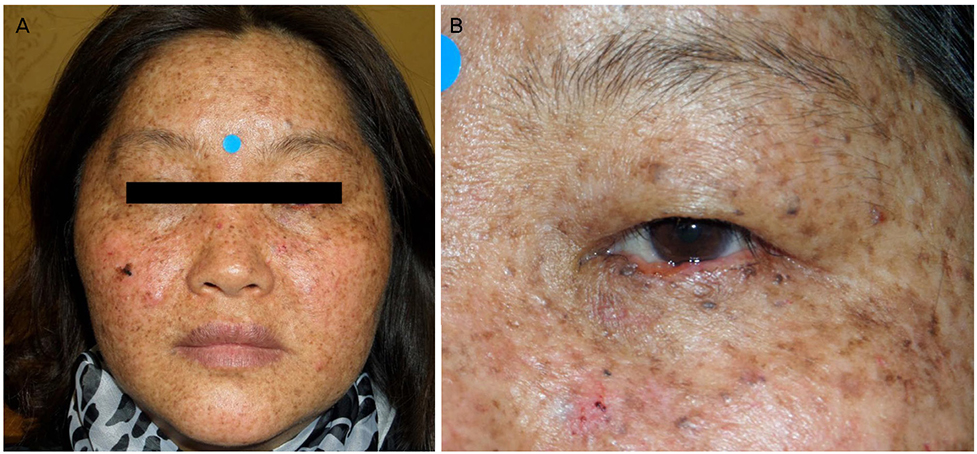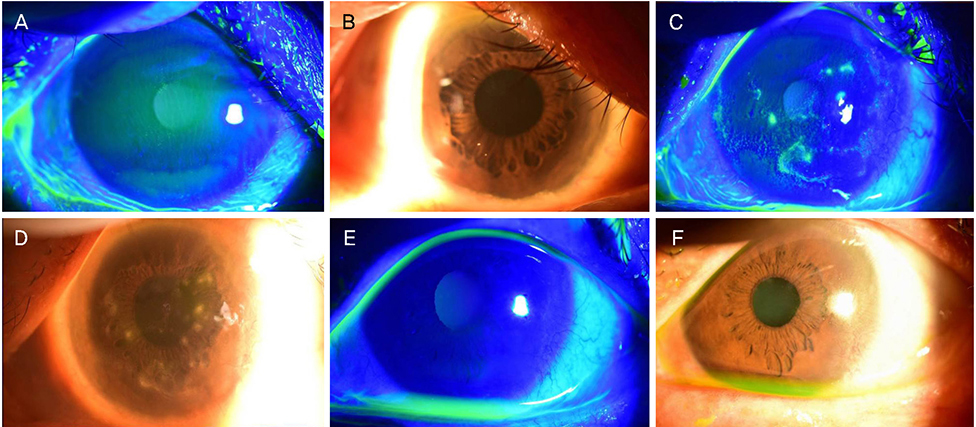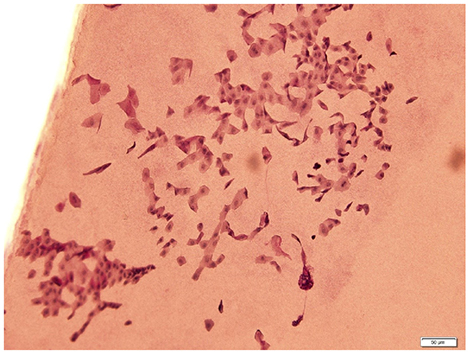J Korean Ophthalmol Soc.
2019 Apr;60(4):380-386. 10.3341/jkos.2019.60.4.380.
A Case of Corneal Dysplasia with Identification of POLH Gene Variants in Xeroderma Pigmentosum
- Affiliations
-
- 1Department of Ophthalmology, Samsung Medical Center, Sungkyunkwan University School of Medicine, Seoul, Korea. ldhlse@gmail.com
- 2Department of Preventive Medicine, Graduate School, The Catholic University of Korea, Seoul, Korea.
- 3Department of Medicine, Graduate School, Kyung Hee University, Seoul, Korea.
- 4Department of Laboratory Medicine and Genetics, Samsung Medical Center, Sungkyunkwan University School of Medicine, Seoul, Korea.
- KMID: 2443156
- DOI: http://doi.org/10.3341/jkos.2019.60.4.380
Abstract
- PURPOSE
To discuss the clinical course and diagnosis of corneal dysplasia in a xeroderma pigmentosum patient based on a genetic evaluation.
CASE SUMMARY
A 42-year-old female visited our clinic for decreased left visual acuity and corneal opacity. She had undergone several surgeries previously due to the presence of basosquamous carcinoma in the left lower eyelid, neurofibroma, and malignant melanoma of the facial skin. The patient showed repeated corneal surface problems, with a suspicious dendritic lesion; however, antiviral therapy was ineffective, and herpes simplex virus polymerase chain reaction results were negative. Despite regular follow-ups, the patient showed neovascularization around the corneal limbus and an irregular corneal surface. We performed corneal debridement with autologous serum eye drops for treatment. The patient's visual acuity and corneal surface improved after the procedure. The impression cytology result was corneal dysplasia. In whole exome sequencing, two pathogenic variants and one likely pathogenic variant of the POLH gene were detected.
CONCLUSIONS
This is the first genetically identified xeroderma pigmentosum case with ophthalmological lesions of the eyelid and cornea in Korea. Debridement of the irregular corneal surface and autologous serum eye drop administration in xeroderma pigmentosum could be helpful for improving visual acuity.
Keyword
MeSH Terms
Figure
Reference
-
1. Brooks BP, Thompson AH, Bishop RJ, et al. Ocular manifestations of xeroderma pigmentosum: long-term follow-up highlights the role of DNA repair in protection from sun damage. Ophthalmology. 2013; 120:1324–1336.2. Chaurasia S, Mulay K, Ramappa M, et al. Corneal changes in xeroderma pigmentosum: a clinicopathologic report. Am J Ophthalmol. 2014; 157:495–500.e2.
Article3. Lehmann AR, McGibbon D, Stefanini M. Xeroderma pigmentosum. Orphanet J Rare Dis. 2011; 6:70.
Article4. Kim MH, Shin JL, Cho BC. A case of limbal squamous cell carcinoma appearing in xeroderma pigmentosum. J Korean Ophthalmol Soc. 1978; 19:473–477.5. Lee YS, Myong YW, Baek NH. A case of ocular manifestation in xeroderma pigmentosum. J Korean Ophthalmol Soc. 1984; 25:555–559.6. Yoon BJ, Jun HS. A case of xeroderma pigmentosum with ocular manifestation. J Korean Ophthalmol Soc. 1985; 26:859–864.7. Cleaver JE. Cancer in xeroderma pigmentosum and related disorders of DNA repair. Nat Rev Cancer. 2005; 5:564–573.
Article8. Fassihi H, Sethi M, Fawcett H, et al. Deep phenotyping of 89 xeroderma pigmentosum patients reveals unexpected heterogeneity dependent on the precise molecular defect. Proc Natl Acad Sci U S A. 2016; 113:E1236–E1245.
Article9. Inui H, Oh KS, Nadem C, et al. Xeroderma pigmentosum-variant patients from America, Europe, and Asia. J Invest Dermatol. 2008; 128:2055–2068.
Article10. Ortega-Recalde O, Vergara JI, Fonseca DJ, et al. Whole-exome sequencing enables rapid determination of xeroderma pigmentosum molecular etiology. PLoS One. 2013; 8:e64692.
Article11. Geerling G, Maclennan S, Hartwig D. Autologous serum eye drops for ocular surface disorders. Br J Ophthalmol. 2004; 88:1467–1474.
Article12. Azari AA, Rapuano CJ. Autologous serum eye drops for the treatment of ocular surface disease. Eye Contact Lens. 2015; 41:133–140.
Article13. Roberson MC. Corneal epithelial dysplasia. Ann Ophthalmol. 1984; 16:1147–1150.14. Opletalova K, Bourillon A, Yang W, et al. Correlation of phenotype/genotype in a cohort of 23 xeroderma pigmentosum-variant patients reveals 12 new disease-causing POLH mutations. Hum Mutat. 2014; 35:117–128.15. DiGiovanna JJ, Kraemer KH. Shining a light on xeroderma pigmentosum. J Invest Dermatol. 2012; 132(3 Pt 2):785–796.
Article
- Full Text Links
- Actions
-
Cited
- CITED
-
- Close
- Share
- Similar articles
-
- Two Cases of Xeroderma Pigmentosum in Brothers
- Diagnosis of Xeroderma Pigmentosum by Measuring Unscheduled DNA Synthesis
- A Case of Limbal Squamous Cell Carcinoma Appearing in Xeroderma Pigmentosum
- A Patient with Xeroderma Pigmentosum Developing Malignant Melanoma and Basal Cell Epithelioma
- Ultraviolet light DNA repair and skin cancers identification of xeroderma pigmentosum D group correcting factor





